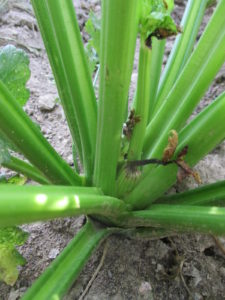Blackheart of celery is a physiological disorder that causes significant crop loss in major celery production areas. It is characterized by the breakdown of young leaf tissues in the heart of the plants (Figure 1). The affected young tissues turn black, which give it the name “blackheart”. The cause of blackheart of celery is related to calcium deficiency in the fast expanding tissues, similar to the cause of blossom-end rot of tomato and tip-burn of lettuce. The symptom is more severe as plants approach maturity. Fluctuation in soil moistures; excessive soil fertility, especially nitrogen and potassium; and high soil salinity favor the development of blackheart. Varieties may show different tolerance to the physiological disorder. In addition, the problem can be prevented by avoiding wide fluctuation of soil moisture and over-fertilization. Drench application and foliar spray of soluble calcium direct to the heart of the plant may help to prevent the physiological disorder.
